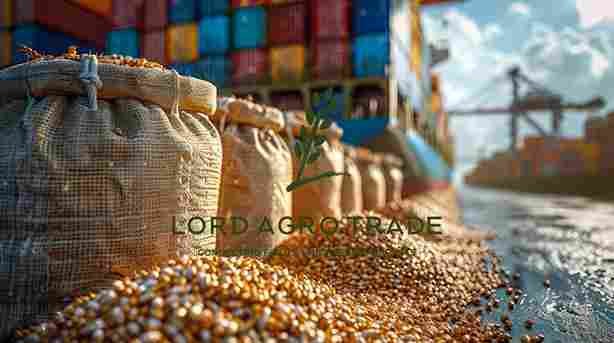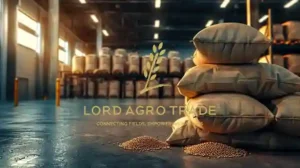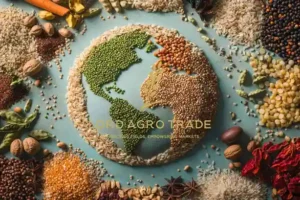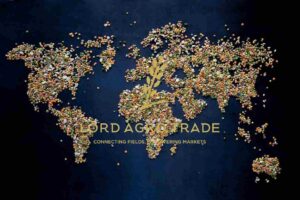Gulfood
17 To 21 FEB 2025 | DUBAI WORLD TRADE CENTRE
We’re excited to see you at Gulfood 2025!
Gulfood
17 To 21 FEB 2025 | DUBAI WORLD TRADE CENTRE
We’re excited to see you at Gulfood 2025!


Pulses, among the most vital sectors of agriculture at present, consequently have an immense role to play in food security worldwide. Pulses are important in global health and sustainable development, with logistics within their importation and export, therefore assuming a place of criticality now more than ever.
Pulses import and export logistics are two of the main success factors in the supply chain, influencing the time, quality, and cost management of this trade. This covers all steps from harvesting and packaging to transportation and delivery to world markets.
Finally, in 2025, big changes will start to take place in pulses trade logistics. Advances in technologies are being adopted, improvements in the structure of transport have started to take place, and environmental sustainability has come more into focus.
The article discusses trends, challenges, and opportunities related to pulse import and export logistics in 2025. Through the practice introduced in the best practices and innovations presented within, this manual will help steer your way to achieving success in a competitive global market.
Since pulses and plant-based diets are gaining momentum in popularity, it would appear that this trend of growth for pulses will only continue well into 2025. Countries worldwide have finally accepted pulses as a sustainable food source that is rich in nutrients, and hence, target markets and trade dynamics have shifted.
New opportunities are being created for exporters by key importers like India, which remains the largest consumer of pulses and emerging markets in Europe, North America, and some parts of Asia.
At the same time, major exporters like Canada, Australia, and Myanmar are increasing their market share by improving their farming techniques, pulse import growing, and export-needs facilities.
Having effective pulses pulse in import and global export markets. Logistics is important because the market pulse is vital for export, and in an import-satisfying system, it should be fast, secure, and affordable to preserve the quality of the pulses. The use of advanced technologies, including AI and tracking, blockchain forecasting, and the movement supply of chain processes, thus reducing pulses in time 2025. and These costs.
Pulses target markets in 2025
The alteration in consumer preferences, market extension, and the ever-present focus on sustainability are some of the influencing factors of the technology trade-assisted pulses. Traders and exporters should learn the pulse concepts of import and export logistics. It is to fully seize the opportunity and sustain relevance in the global markets.

As logistics are an integral part of the pulses supply chain backbone, they ensure movement from the producers to consumers of the products in good quality at cheaper costs. The imports and exports logistics in Pulse have played an essential role from the collection stage through all processing stages until the final delivery in international markets.
Collection and storage
The collection of pulses from farms into suitable facilities is the first in the chain of logistics. Good storage maintains quality and contains spoilage. The temperature-controlled warehouse logistics deserve special mention mainly to maintain the integrity of pulses during peak harvest times.
Packaging and labeling
Logistics ensures that the critical steps of packaging and labelling are taken to prepare the pulses in conformance with international standards. Good packaging reduces wastage, provides protection in transit, and aids in transport, ensuring that all critical processes concerning the pulses are carried out according to international standards, such as packaging and labelling.
Good packaging reduces wastage and protection in transit and helps comply with rules. Proper labelling also ensures smooth customs clearance, an important part of transporting pulses outside the country or into it. ompliance with regulations. Proper labelling will also ensure smooth customs clearance, another important part of the logistics in the import and export of pulses.
Domestic and international transportation
The core of the entire logistics that is involved in the import and export of pulses is transportation: from local transport from farms to the processing units to international shipments to reach global markets.
The choice of transport road, rail, or sea- is determined by cost, urgency, and market demand. In modern times, exporters do is that they can appropriately reduce time and improve customer service through modern systems that help them know the location of their shipments anywhere in the world in real-time.
Impact on time, quality, and costs
The effective management of logistics management directly impacts the supply chain by:
Smart technologies in the IoT and AI will transform the pulse import and export logistics supply chain by 2025. These innovations help businesses optimize routes, predict demand, and automate redundant processes to sustain and enhance operational efficiency.
Focused on ensuring that optimal processing and packing, from seed production to end-user delivery, is accomplished while guaranteeing that the pulses fit every aspect of the seldom-fulfilled consumer demand across the globe, pulse import and export logistics cover the entire supply chain.

The global trade of pulses, though a big opportunity, has various logistical problems that may hamper smooth operations. Efficient import and export logistics of pulses demand the resolution of these challenges to ensure seamless delivery and competitive advantage in international markets. Following are the major logistical issues that are faced in the pulses trade:
Transportation-related inefficiencies are one of the major challenges to pulse import and export logistics. These include:
Container Shortages: The global shortage of shipment containers has delayed the movement of pulses, which elongates lead times and distorts supply chains.
High Costs of Transport: Skyrocketing fuel prices and shipping rates have inflated the cost structures of international trade, making exportation less competitive.
The second important logistical challenge for imports and exports of pulses is dealing with the complexity of international trade regulations:
Regulatory compliance: Compliance with various countries’ import requirements on labelling, quality standards, and phytosanitary certification is time-consuming and expensive. Customs Delays: Long clearances at ports and often border checks delay the consignment and result in pulses that may not be fresh or of good quality.
Changing weather and environmental conditions further threaten the logistics of importing and exporting pulses:
Unpredictive Weather: Inclement weather, such as storms or floods, disrupts routes of transport and postpones shipments.
Temperature Sensitivity: Pulses are sensitive to the temperature and humidity factor, which will result in the decaying of this commodity during transport if logistics are not appropriately devised to handle this challenge.
Responding to these challenges
For the stakeholders in pulses trade to hurdle such challenges, adopting innovative solutions in:
Leveraging Technology: Advanced tracking systems and AI-driven forecasting tools will further enhance the route and efficiency of pulses’ import and export logistics.
Sustainable Practices: Sustainable logistics solutions, eco-friendly transport modes, and sustainable packaging can mitigate environmental impacts; investing in their development would provide a good payoff.
Smoothening Processes: Collaboration with experienced logistics providers will, therefore, enable business enterprises to overcome regulatory requirements and reduce customs delays.
Overcoming these challenges in 2025 would be critical to increasing the global pulses trade.
If exporters solve these problems on time, this will keep the import and export logistics of pulses smooth and time-worthy to respond positively to the demand increase around the globe.
Suggested blog: Largest Lentil Producers in 2025 and Beyond
The international demand for pulses is increasing, hence, the need to meet international regulations and standards has also become an important part of import and export logistics for pulses. Meeting such requirements is going to be crucial for 2025 smooth trade operations and maintaining the quality and safety of products.
Licensing and Permissions: Most exporters and importers need to obtain several licenses before initiating any international trade of goods. It includes, normally, export permits, import authorization, phytosanitary certificates, etc., and other sanitary certifications by competent exporting authorities that convince the importing country pulse exports to conform to their requirements in terms of safety and quality standards.
Packaging Standards: Import and export logistics of pulses require proper packaging to maintain the quality of the product throughout the journey. Exporters are supposed to use only ‘environment-friendly’ materials for packaging, which in turn should also be duly labeled in compliance with international requirements, stating origin, weight, and nutritional information.
Certification Requirements: To increase credibility among suppliers in the competitive global market, ISO standards, organic certifications, or fair trade labels are some added advantages.
Trade agreements between countries have a great impact on the import and export logistics of pulses. Some of these aspects are as follows: Tariff Reductions: Agreements like FTAs or regional trade partnerships can reduce tariffs, making the export of pulses more economically viable to certain markets. Smooth Customs Procedure: Harmonized customs regulations and electronic documentation under such agreements reduce delays and simplify logistics processes.
Market Access: Trade agreements open up new markets for exporters, enabling them to expand their business and take full advantage of their pulses import and export logistics strategy.
Sustainability Regulations: Starting in 2025, new environmental regulations will force exporters to shift toward greener practices in the logistics of pulses import and export, such as carbon footprint reduction and the use of recyclable materials.
Digital Transformation: Most countries are now introducing digital trade platforms to make this process easier. Using such a platform ensures quicker approvals and real-time tracking of shipments.
Following the regulations and trade agreements will ensure that the pulses will reach their destination without delays or penalties. Good pulses import and export logistics management in 2025 means knowing the changing laws, leveraging the trade benefits, and using the best practices.
Being aligned with international standards and agreements can smoothly align business firms to fully take advantage of the growing demand for pulses across the world, thus positioning themselves as competitors in the marketplace.

Conclusion
Pulses import and export logistics form a vital component of the overall international trade of pulses in 2025, while the shipments of such critical food items are delivered to their required destinations efficiently and in very good condition. In today’s ever-increasing competition, efficient management of logistics is not merely an operational need but has assumed the role of a strategic differentiator.
Amongst these, some major integration factors within the optimization of pulses import and export logistics in 2025 include advanced technologies, evolving regulations, and the use of sustainable practices. Such businesses would, after overcoming many of these logistically inhibiting factors that involve costs of transportation, regulatory barriers, and environmental concerns, be in a better position to streamline supply chain operations and deliver quality pulses on time, meeting the increased global demand.
These portend significant opportunities for stakeholders in the pulses trade. With proper planning, investment in innovative logistics solutions, and a focus on sustainability, exporters and importers alike will be well-positioned to seize this fast-growing global market. Excellence in pulses import and export logistics in 2025 will thus drive businesses toward profitability while supporting world food security and sustainable development.